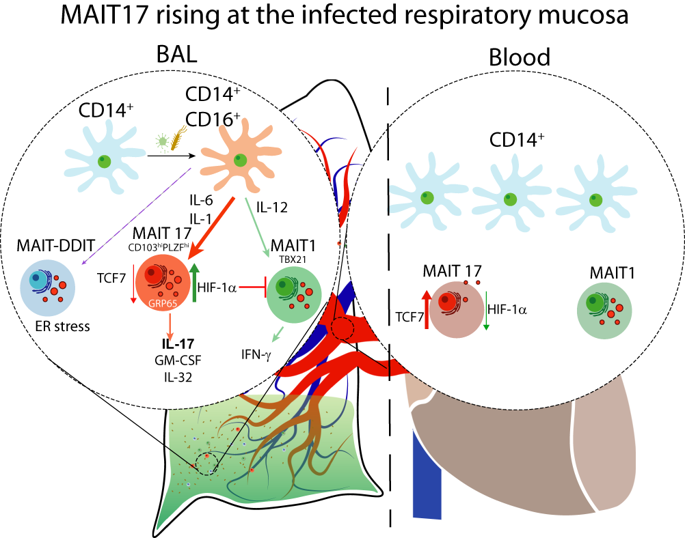当前位置:
X-MOL 学术
›
Mucosal Immunol.
›
论文详情
Our official English website, www.x-mol.net, welcomes your
feedback! (Note: you will need to create a separate account there.)
IL-17 production by tissue-resident MAIT cells is locally induced in children with pneumonia.
Mucosal Immunology ( IF 7.9 ) Pub Date : 2020-02-28 , DOI: 10.1038/s41385-020-0273-y Bingtai Lu 1, 2 , Ming Liu 1, 3 , Jun Wang 1 , Huifeng Fan 1 , Diyuan Yang 1 , Li Zhang 1 , Xiaoqiong Gu 1 , Junli Nie 1 , Zhenjun Chen 4 , Alexandra J Corbett 4 , Michael J Zhan 5 , Shengbo Zhang 6 , Vanessa L Bryant 6, 7 , Andrew M Lew 4, 6, 7 , James McCluskey 4 , Hai-Bin Luo 3 , Jun Cui 2 , Yuxia Zhang 1 , Yifan Zhan 1, 6, 7 , Gen Lu 1
Mucosal Immunology ( IF 7.9 ) Pub Date : 2020-02-28 , DOI: 10.1038/s41385-020-0273-y Bingtai Lu 1, 2 , Ming Liu 1, 3 , Jun Wang 1 , Huifeng Fan 1 , Diyuan Yang 1 , Li Zhang 1 , Xiaoqiong Gu 1 , Junli Nie 1 , Zhenjun Chen 4 , Alexandra J Corbett 4 , Michael J Zhan 5 , Shengbo Zhang 6 , Vanessa L Bryant 6, 7 , Andrew M Lew 4, 6, 7 , James McCluskey 4 , Hai-Bin Luo 3 , Jun Cui 2 , Yuxia Zhang 1 , Yifan Zhan 1, 6, 7 , Gen Lu 1
Affiliation

|
Community-acquired pneumonia (CAP) contributes substantially to morbidity and mortality in children under the age of 5 years. In examining bronchoalveolar lavages (BALs) of children with CAP, we found that interleukin-17 (IL-17) production was significantly increased in severe CAP. Immune profiling showed that mucosal-associated invariant T (MAIT) cells from the BALs, but not blood, of CAP patients actively produced IL-17 (MAIT17). Single-cell RNA-sequencing revealed that MAIT17 resided in a BAL-resident PLZFhiCD103+ MAIT subset with high expression of hypoxia-inducible factor 1α (HIF-1α), reflecting the hypoxic state of the inflamed tissue. CAP BALs also contained a T-bet+ MAIT1 subset and a novel DDIT3+ (DNA damage-inducible transcript 3-positive) MAIT subset with low expression of HIF1A. Furthermore, MAIT17 differed from T-helper type 17 (Th17) cells in the expression of genes related to tissue location, innateness, and cytotoxicity. Finally, we showed that BAL monocytes were hyper-inflammatory and elicited differentiation of MAIT17. Thus, tissue-resident MAIT17 cells are induced at the infected respiratory mucosa, likely influenced by inflammatory monocytes, and contribute to IL-17-mediated inflammation during CAP.
中文翻译:

组织驻留 MAIT 细胞产生的 IL-17 在肺炎儿童中被局部诱导。
社区获得性肺炎 (CAP) 大大增加了 5 岁以下儿童的发病率和死亡率。在检查 CAP 患儿的支气管肺泡灌洗液 (BALs) 时,我们发现严重 CAP 的白细胞介素 17 (IL-17) 产生显着增加。免疫分析表明,来自 CAP 患者 BAL 而非血液的粘膜相关不变 T (MAIT) 细胞会积极产生 IL-17 (MAIT17)。单细胞 RNA 测序显示 MAIT17 存在于 BAL 驻留的 PLZFhiCD103+ MAIT 子集中,高表达缺氧诱导因子 1α (HIF-1α),反映了发炎组织的缺氧状态。CAP BAL 还包含一个 T-bet+ MAIT1 子集和一个 HIF1A 低表达的新型 DDIT3+(DNA 损伤诱导转录本 3 阳性)MAIT 子集。此外,MAIT17 与 T 辅助细胞 17 型 (Th17) 细胞的不同之处在于与组织位置、先天性和细胞毒性相关的基因表达。最后,我们发现 BAL 单核细胞过度炎症并引起 MAIT17 的分化。因此,组织驻留的 MAIT17 细胞在受感染的呼吸道粘膜处被诱导,可能受炎症单核细胞的影响,并在 CAP 期间促成 IL-17 介导的炎症。
更新日期:2020-02-28
中文翻译:

组织驻留 MAIT 细胞产生的 IL-17 在肺炎儿童中被局部诱导。
社区获得性肺炎 (CAP) 大大增加了 5 岁以下儿童的发病率和死亡率。在检查 CAP 患儿的支气管肺泡灌洗液 (BALs) 时,我们发现严重 CAP 的白细胞介素 17 (IL-17) 产生显着增加。免疫分析表明,来自 CAP 患者 BAL 而非血液的粘膜相关不变 T (MAIT) 细胞会积极产生 IL-17 (MAIT17)。单细胞 RNA 测序显示 MAIT17 存在于 BAL 驻留的 PLZFhiCD103+ MAIT 子集中,高表达缺氧诱导因子 1α (HIF-1α),反映了发炎组织的缺氧状态。CAP BAL 还包含一个 T-bet+ MAIT1 子集和一个 HIF1A 低表达的新型 DDIT3+(DNA 损伤诱导转录本 3 阳性)MAIT 子集。此外,MAIT17 与 T 辅助细胞 17 型 (Th17) 细胞的不同之处在于与组织位置、先天性和细胞毒性相关的基因表达。最后,我们发现 BAL 单核细胞过度炎症并引起 MAIT17 的分化。因此,组织驻留的 MAIT17 细胞在受感染的呼吸道粘膜处被诱导,可能受炎症单核细胞的影响,并在 CAP 期间促成 IL-17 介导的炎症。











































 京公网安备 11010802027423号
京公网安备 11010802027423号